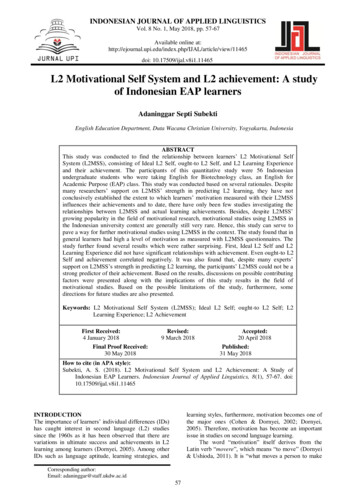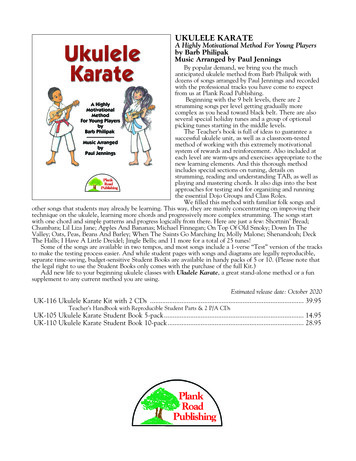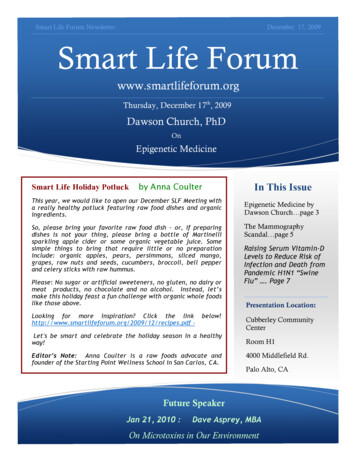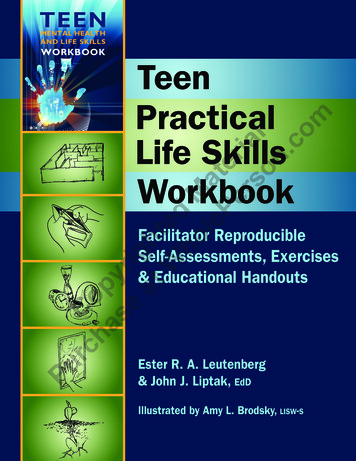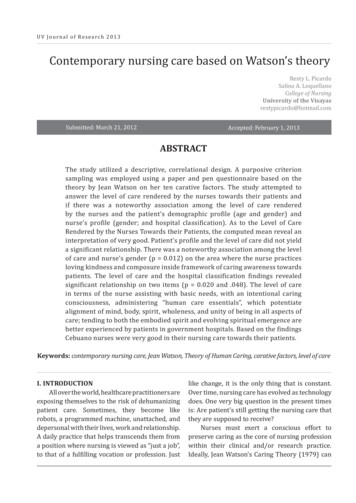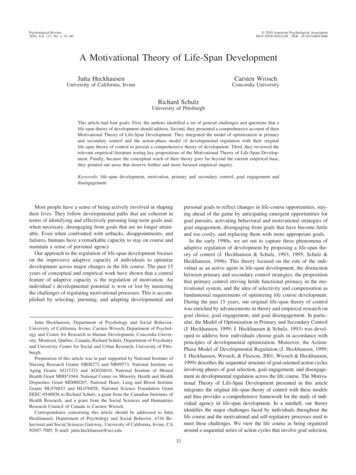
Transcription
Psychological Review2010, Vol. 117, No. 1, 32– 60 2010 American Psychological Association0033-295X/10/ 12.00 DOI: 10.1037/a0017668A Motivational Theory of Life-Span DevelopmentJutta HeckhausenCarsten WroschUniversity of California, IrvineConcordia UniversityRichard SchulzUniversity of PittsburghThis article had four goals. First, the authors identified a set of general challenges and questions that alife-span theory of development should address. Second, they presented a comprehensive account of theirMotivational Theory of Life-Span Development. They integrated the model of optimization in primaryand secondary control and the action-phase model of developmental regulation with their originallife-span theory of control to present a comprehensive theory of development. Third, they reviewed therelevant empirical literature testing key propositions of the Motivational Theory of Life-Span Development. Finally, because the conceptual reach of their theory goes far beyond the current empirical base,they pointed out areas that deserve further and more focused empirical inquiry.Keywords: life-span development, motivation, primary and secondary control, goal engagement anddisengagementpersonal goals to reflect changes in life-course opportunities, staying ahead of the game by anticipating emergent opportunities forgoal pursuits, activating behavioral and motivational strategies ofgoal engagement, disengaging from goals that have become futileand too costly, and replacing them with more appropriate goals.In the early 1990s, we set out to capture these phenomena ofadaptive regulation of development by proposing a life-span theory of control (J. Heckhausen & Schulz, 1993, 1995; Schulz &Heckhausen, 1996). This theory focused on the role of the individual as an active agent in life-span development, the distinctionbetween primary and secondary control strategies, the propositionthat primary control striving holds functional primacy in the motivational system, and the idea of selectivity and compensation asfundamental requirements of optimizing life course development.During the past 15 years, our original life-span theory of controlwas enriched by advancements in theory and empirical research ongoal choice, goal engagement, and goal disengagement. In particular, the Model of Optimization in Primary and Secondary Control(J. Heckhausen, 1999; J. Heckhausen & Schulz, 1993) was developed to address how individuals choose goals in accordance withprinciples of developmental optimization. Moreover, the ActionPhase Model of Developmental Regulation (J. Heckhausen, 1999;J. Heckhausen, Wrosch, & Fleeson, 2001; Wrosch & Heckhausen,1999) describes the sequential structure of goal-oriented action cyclesinvolving phases of goal selection, goal engagement, and disengagement in developmental regulation across the life course. The Motivational Theory of Life-Span Development presented in this articleintegrates the original life-span theory of control with these modelsand thus provides a comprehensive framework for the study of individual agency in life-span development. In a nutshell, our theoryidentifies the major challenges faced by individuals throughout thelife course and the motivational and self-regulatory processes used tomeet these challenges. We view the life course as being organizedaround a sequential series of action cycles that involve goal selection,Most people have a sense of being actively involved in shapingtheir lives. They follow developmental paths that are coherent interms of identifying and effectively pursuing long-term goals and,when necessary, disengaging from goals that are no longer attainable. Even when confronted with setbacks, disappointments, andfailures, humans have a remarkable capacity to stay on course andmaintain a sense of personal agency.Our approach to the regulation of life-span development focuseson the impressive adaptive capacity of individuals to optimizedevelopment across major changes in the life course. The past 15years of conceptual and empirical work have shown that a centralfeature of adaptive capacity is the regulation of motivation. Anindividual’s developmental potential is won or lost by masteringthe challenges of regulating motivational processes. This is accomplished by selecting, pursuing, and adapting developmental andJutta Heckhausen, Department of Psychology and Social Behavior,University of California, Irvine; Carsten Wrosch, Department of Psychology and Centre for Research in Human Development, Concordia University, Montreal, Québec, Canada; Richard Schulz, Department of Psychiatryand University Center for Social and Urban Research, University of Pittsburgh.Preparation of this article was in part supported by National Institute ofNursing Research Grants NR08272 and NR09573, National Institute onAging Grants AG15321 and AG026010, National Institute of MentalHealth Grant MH071944, National Center on Minority Health and HealthDisparities Grant MD000207, National Heart, Lung and Blood InstituteGrants HL076852 and HL076858, National Science Foundation GrantEEEC-0540856 to Richard Schulz, a grant from the Canadian Institutes ofHealth Research, and a grant from the Social Sciences and HumanitiesResearch Council of Canada to Carsten Wrosch.Correspondence concerning this article should be addressed to JuttaHeckhausen, Department of Psychology and Social Behavior, 4316 Behavioral and Social Sciences Gateway, University of California, Irvine, CA92697-7085. E-mail: jutta.heckhausen@uci.edu32
A MOTIVATIONAL THEORY OF LIFE-SPAN DEVELOPMENTgoal pursuit, and disengagement from goals. Both optimal and nonoptimal strategies for each phase of this cycle are identified along withkey transition points and relevant control strategies.The goals of this article are fourfold. First, we identify a set ofgeneral challenges and questions that a life-span theory of development should address. Second, we present a comprehensive account of our Motivational Theory of Life-Span Development anddiscuss how the theory meets these challenges. Third, we reviewthe relevant empirical literature, testing 15 key propositions of theMotivational Theory of Life-Span Development. Finally, becausethe conceptual reach of our theory goes far beyond the currentempirical base, we identify several additional areas of inquiry toguide future empirical research.General Challenges and Questions to Be Addressedby Life-Span Developmental ResearchIn our original life-span theory of control, we identified keyissues that need to be addressed by all life-span theories of development (J. Heckhausen & Schulz, 1995; Schulz & Heckhausen,1996). Here we refine these propositions to lay the foundation forour Motivational Theory of Life-Span Development.Criteria for Adaptive DevelopmentAny effective theory of life-span development needs to specifywhich criteria it is using to differentiate desirable and adaptivefrom undesirable and maladaptive outcomes and patterns of development. Approaches to life-span development and aging varywidely with regard to the kind of criteria they use (Schulz &Heckhausen, 1996). Depending on the focus of the scientificapproach, successful development can be gauged through indicators of physiological functioning, such as cardiovascular and pulmonary status (Rowe & Kahn, 1987), cognitive and intellectualperformance (Heine, Lehman, Markus, & Kitayama, 1999; Salthouse, 1991; Simonton, 1988), or achievement in physical (Schulz& Curnow, 1988) or artistic domains (Ericsson, Krampe, & TeschRömer, 1993; Lehman, 1953; Simonton, 1988). The commoncharacteristic of all these criteria is that they reflect broad measurable standards of functioning or performance upon which members of a given society generally agree.Moreover, these broad indicators can be applied to individuals atdifferent ages using absolute standards (e.g., world record performance in 100-m dash) or relative standards (e.g., best 100-m dashperformance for 60-year-olds) that take into account the specificconstraints on the individual (e.g., age, disability, lack of training).Finally, such measurable indicators can also help to assess whethera specific individual shows developmental growth or decline relative to his or her own previous performance.One difficulty with using single domain-specific standards of adaptation and mastery is that individuals usually cannot afford to investin only one domain without seriously compromising mastery in otherdomains of life. Most individuals strike a balance by investing effortand time in multiple common life domains, such as education, work,social relations and family, health, and leisure activities. It is theoverall mastery across different domains of life and functioning thatdefines the individual’s overall level of success.Moreover, one can assess successful adaptation at two levels ofanalysis: one addressing mastery specific to the individual’s cur-33rent location in a life-course trajectory and the other addressing thetotality of mastery attained during the individual’s life. For example, pursuing a career as a world-class athlete may maximizemastery in a particular domain during the peak performance periodin late adolescence and young adulthood but may seriously compromise the ability to master other domains or one’s health at laterphases in life. Thus, criteria for adaptive development should becomprehensive in addressing multiple domains of functioning andthe totality of mastery across the individual’s life span and shouldtake into account the constraints on the individual that limit goalattainment.Some researchers in life-span development have argued formore subjective and individualized criteria of psychological experience, such as life satisfaction or psychological well-being (Baltes& Baltes, 1990). One variant of this approach is to conceptualizesuccess in terms of goal attainment, subjectively defined as therealization of desired outcomes and the avoidance of undesiredoutcomes (Marsiske, Lang, Baltes, & Baltes, 1995). A relatedvariant of this subjective approach proposes that self-consistencyis the ultimate criterion of adaptiveness and consequently viewsdownward adjustments of goals and strivings for goal attainmentas equivalent means for achieving self-consistency (Brandtstädter& Rothermund, 2002). The common denominator of these moresubjective approaches is the notion that adaptiveness is capturednot so much by what a person does or accomplishes but, rather, byhow a person perceives his or her accomplishments. These subjective approaches offer some appeal for those who follow aphenomenological orientation, but they come with serious drawbacks. First, subjective criteria are individually determined andthus cannot be used for interindividual comparisons of developmental outcomes. Second, they are subject to the rationalizationbiases individuals often use when they evaluate their own experiences and accomplishments. Third, subjective approaches fail totake advantage of the fact that there is substantial consensus acrosscultures about what constitutes success in life (e.g., physical,cognitive, intellectual, affective, and creative functioning; socialrelations; social status; integrity).To summarize, an effective life-span developmental theoryneeds to include criteria for adaptive development that can beassessed in ways that facilitate interindividual comparison, preventdistortion by subjective biases, and build on cross-cultural consensus about what constitutes a successful life.Individual Agency and Developmental GoalsMost developmental scientists would agree that individualagency plays a crucial role in human development across the lifespan (Baltes, Lindenberger, & Staudinger, 1998; Brandtstädter,2006; J. Heckhausen, 1999; Lerner & Busch-Rossnagel, 1981).Indeed, the active and goal-oriented role of individuals in theirown development is a central proposition of the widely acceptedorganismic model of development (Lerner, 2002; Reese & Overton, 1970; von Bertalanffy, 1968). The importance of agency hasbeen further elaborated in models of intentional self-development,which use action theory to conceptualize the individual’s attemptsto influence his or her own development (e.g., Brandtstädter, 2006;Brandtstädter, Wentura, & Rothermund, 1999; Heckhausen,1999).
34HECKHAUSEN, WROSCH, AND SCHULZHumans develop mental representations about desired outcomesof life-course transitions and developmental processes. Often thesedesired outcomes are strongly influenced by what society hascome to identify as a developmental task for a given age period orlife-course transition (Havighurst, 1952). These desired outcomesor developmental tasks are adopted by the individual as developmental goals toward which to strive and can thus organize theactive attempts of individuals to influence their own development.Many developmental researchers therefore focus on goal-relatedconcepts when investigating individual contributions to life-spandevelopment. A variety of different terms have been used tocharacterize these goals, including personal projects (Little, 1983;Little, Salmela-Aro, & Phillips, 2007), life goals (Nurmi, 1992,1993), personal goals (Brunstein, 1993; Brunstein, Schultheiss, &Maier, 1999; Riediger, Freund, & Baltes, 2005; Salmela-Aro,Aunola, & Nurmi, 2007; Wadsworth & Ford, 1983), personalstrivings (Emmons, 1986), personal life tasks (Cantor & Fleeson,1991), goals of intentional self-development (Brandtstädter, Wentura, & Rothermund, 1999), and possible selves (Cross & Markus,1991; Markus & Nurius, 1986). The empirical research on thesegoal-related concepts reflects the specific challenges associatedwith human goal-related striving in the context of the life course.In general, development-related goal concepts share three characteristics that make them particularly suited for the life-coursecontext. First, developmental goals are directed at developmentalprocesses (e.g., become more independent from my parents) orlife-course attainments (e.g., start a career, get married). Thisimplies that the unique action field for developmental goals is thelife course with its specific age-graded structure of opportunitiesand constraints (see the next section). Second, developmentalgoals comprise desired outcomes at an intermediate level of aggregation (e.g., improve my grades, graduate from college, have achild), between very specific projects (e.g., get an A on the nextexam), and broad values (e.g., promote world peace) or motives(e.g., improve my overall mastery). Third (related to the secondpoint), developmental goals typically reach into the intermediatefuture, 5–10 years ahead, either within the current or next phase ofthe life course (e.g., within adolescence or from adolescence intoearly adulthood).To summarize, an effective life-span developmental theoryshould view the individual as an active agent in life-span development. Thus, individual agency should be studied by addressingmotivational processes involved in goal selection, goal pursuit, andgoal disengagement.Changing Opportunities and Constraints Across theLife CourseIndividuals have to adjust to, cope with, and take advantage ofthe changing opportunities and constraints characteristic of different stages in life. Biological maturation and aging and societalinstitutions (e.g., education, labor market, retirement) set up aroughly inverted U-shaped curve of control capacity across the lifespan, with a steep increase during childhood and adolescence, apeak in young adulthood and middle age, and a decline in old age.This general life-course trajectory of first increasing and thendecreasing opportunities is overlaid with more domain-specifictrajectories of improving and declining opportunities for achievingspecific developmental goals. Societal institutions, such as theeducational system, vocational career patterns, and welfare systems, structure the life span in terms of critical transitions (e.g.,school entry, promotions, retirement) and sequential constraints(e.g., educational qualifications as prerequisites for certain careers). These time-organized opportunity structures present significant regulatory challenges to the individual who must respond ina time- or age-sensitive way. Moreover, the individual needs tocome to terms with diminished chances of attaining important lifegoals, once the opportunities pass by. In summary, any effectivetheory of life-span development needs to address the way in whichlife-course variations in opportunities and constraints are met withindividuals’ attempts to master their own development.Selectivity and Compensation as FundamentalRegulatory ChallengesMajor approaches to life-span development converge in asserting that the regulatory challenges encountered throughout the lifecourse require that the individual masters two fundamental regulatory challenges: selectivity of resource investment and compensation of failure and loss (Bäckman & Dixon, 1992; Baltes &Baltes, 1990; Baltes et al., 1998; Brandtstädter, 2006; J. Heckhausen, 1999; J. Heckhausen & Schulz, 1993; Salthouse, 1985).Selectivity of goal investment acknowledges the fact that wecannot strive for all goals at once, or even sequentially. Paul andMargret Baltes’s model of selective optimization with compensation championed the idea of selectiveness in life-span development, particularly for successful aging (Baltes, 1987; Baltes &Baltes, 1990). The human potential for controlling the environment is multifaceted but resource- and time-limited; as a result,people have to be selective about which goals to pursue and whenthey pursue them. This implies that they relinquish goals thatoverstretch or might undermine their capacity to reach specificlong-term goals. For example, giving up on postsecondary education may help an athlete’s career in the short run but may compromise his or her potential for effectively influencing his or herenvironment in the long run. Another more domain-specific example is how individuals exhibit socioemotional selectivity inwhich social partners they select and maintain at different times oflife (Lang, 2001; Lang & Carstensen, 1994; Lang & Heckhausen,2006), depending on whether the life phase requires access to newinformation or socioemotional well-being (Carstensen, Isaacowitz,& Charles, 1999).Compensation of failure and loss is essential for developmentalregulation, because humans experience setbacks in their goal striving not only in old age (Salthouse, 1985) but also normativelyacross the entire life span (Bäckman & Dixon, 1992; J. Heckhausen, 1999). Mastery development is maximized at intermediatelevels of difficulty, when failure occurs at about 50% of attempts.Thus, development of mastery cannot thrive unless individualshave effective means of dealing with failure, both in terms ofcorrecting their behavior and in terms of protecting their motivational and emotional resources against the undermining effects offailure (e.g., loss of hope for success, decline in self-esteem,hopelessness). Life-span developmental psychologists have focusedon different aspects of compensation, with some primarily addressingattempts to hone action strategies to overcome and undo previousfailures (e.g., Bäckman & Dixon, 1992) and others focusing on howindividuals prevent or counteract negative affective or self-evaluative
A MOTIVATIONAL THEORY OF LIFE-SPAN DEVELOPMENTconsequences of failure. For example, the accommodative tendencies,investigated by Brandtstädter et al. (1999), help the individual adjustgoals to what is feasible and protect the individual against self-blamefor failure. In sum, an effective life-span developmental theory needsto address processes that help the individual to select appropriategoals in which to invest and to compensate for failures, setbacks, andlosses when they occur.The Motivational Theory of Life-Span DevelopmentIn this section, we discuss how the Motivational Theory ofLife-Span Development addresses the major challenges raised inthe previous section. We subsume under the theoretical umbrellaof our Motivational Theory of Life-Span Development the originallife-span theory of control (J. Heckhausen & Schulz, 1993, 1995;Schulz & Heckhausen, 1996) and its elaboration in two relatedprocess models: the Model of Optimization in Primary and Secondary Control (J. Heckhausen, 1999; J. Heckhausen & Schulz,1993), which addresses the control processes involved in goalengagement and goal disengagement, and the Action-Phase Modelof Developmental Regulation (J. Heckhausen, 1999; J. Heckhausen et al., 2001; Wrosch & Heckhausen, 1999), which addresses the sequential structure of goal engagement and disengagement across the life course. Our original life-span theory of controlput forward propositions about primary control as the criterion ofadaptive development and about life-span trajectories of primaryand secondary control, which are addressed in the first two following sections. Subsequent sections greatly expand the reach andspecificity of the original theory by incorporating empirical findings and conceptual developments (i.e., Optimization in Primaryand Secondary Control and the Action Phase Model of Developmental Regulation) that have occurred over the past 15 years.Primary Control Capacity as Criterion ofAdaptive DevelopmentOur Motivational Theory of Life-Span Development proposesthat the key criterion for adaptive development is the extent towhich the individual realizes control of his or her environment(i.e., primary control) across different domains of life and acrossthe life span (J. Heckhausen, 1999; J. Heckhausen & Schulz, 1995,1999b; Schulz & Heckhausen, 1996). To further elaborate thisproposition, we adapted a conceptual distinction, first made byRothbaum, Weisz, and Snyder (1982), between primary and secondary control processes. According to Rothbaum et al., primarycontrol processes are conceptualized as directed at changing theworld to bring the environment into line with one’s wishes. Incontrast, secondary control processes are defined as changing theself to bring oneself into line with environmental forces. The twoprocesses together are proposed to optimize an individual’s senseof control, even when circumstances constrain the individual’scapacity to control the environment.Using Rothbaum et al.’s (1982) basic distinction between primary and secondary control, our life-span theory of control specified their functional relations more explicitly and formulated theirimplications for life-span development. According to our life-spantheory of control, the motivational system is set up to maximizeprimary control capacity across life domains and lifetime (J. Heckhausen & Schulz, 1993, 1995, 1999b; Schulz & Heckhausen, 1996,351997). From a functionalist and evolutionary psychology perspective,primary control striving is essential for mastering the challengesassociated with maximizing inclusive fitness, such as foraging forfood, seeking shelter, competing for mates, and caring for offspring(J. Heckhausen, 2000b; J. Heckhausen & Schulz, 1999b). Moreover,primary control striving is promoted by basic motivational modulesthat have been favored in mammalian evolution (J. Heckhausen,2000b): a preference for behavior-event over event-event contingencies (White, 1959), a ubiquitous tendency for novelty exploration(Schneider, 1996), and the asymmetry of emotional responses topositive and negative events (Frijda, 1988). The latter pattern ofresponses reflects stronger and more prolonged aversive affectiveresponses to negative events when compared with the beneficialaffective consequences of positive events, a pattern that effectivelypromotes primary control striving and avoids “resting on one’s laurels.” Thus, behavioral evolution has favored mechanisms of motivational self-regulation that maximize primary control striving.Primary and secondary control processes work together to maximize the overall primary control capacity of an individual. Primarycontrol capacity varies across domains and age and reflects individuals’ ability to influence important outcomes in their environment. Atany given point in the life span, development is adaptive to the extentthat it realizes a maximum of primary control, taking into account notonly the current ability to control external events but also the futurepotential for exercising primary control. For example, an expansion ofcontrol in one domain, such as gymnastics, would not be optimal if itseriously compromises control in the future because of impairedskeletal growth. The primacy of primary control principle wouldrequire a disengagement from goals with such negative side effectsfor a person’s long-term primary control capacity. In other words, themost adaptive development across the life course is achieved bymaximizing primary control in the multiple major domains of functioning (e.g., work, family, health, leisure) and across the differentphases of the life span.The life-span theory of control identifies the function of secondarycontrol more specifically than did Rothbaum et al. (1982). Accordingto our model, secondary control strategies address internal, mostnotably motivational, processes to minimize losses in, maintain, andexpand existing levels of primary control. Thus, we conceptualizedsecondary control strategies as auxiliary motivational processes thatsupport short-term or long-term primary control striving, not as alternatives or even processes opposed to primary control.The proposition that secondary control processes serve primarycontrol striving proved to be an important point of departure forour theory when compared with the earlier work of Rothbaum etal. (1982). This led us and others (e.g., Bailis, Boerner, Chipperfield, Gitlin, Hall, Light, Isaacovitz, McQuillen, Salmela-Aro,Wahl) following our theoretical framework on to a path quitedistinct from investigators who adopted the older view that secondary control processes are solely directed at acceptance, givingup, and fitting in (Morling & Evered, 2006; Morling, Kitayama, &Miyamoto, 2003; Skinner, 2007; Thompson, Soboloew-Shubin,Galbraith, Schwankovsky, & Cruzen, 1993). It is important to note inthis context that our conception of primary and secondary controlprocesses was from the beginning focused on control striving and thusmotivational phenomena, rather than merely at perceptions of control,a phenomenon of social cognition that used to be the most commonlyaddressed aspect of control behavior in the 1980s and early 1990s (seereview in Skinner, 1996).
36HECKHAUSEN, WROSCH, AND SCHULZThe life-span theory of control views humans universally asmotivated by achieving effects in their environment (White,1959). We set out to investigate how individuals manage tomaintain an active agenda of striving for primary control as theyencounter great challenges during their life course in terms ofboth gains and losses in actual control potential. As reported inthe section on life-span trajectories of control striving below,primary control striving remains stable and a dominant motivational source throughout adulthood and into older age(J. Heckhausen, 1997).Life-Span Trajectories of Primaryand Secondary ControlOur life-span theory of control proposed hypothetical life-spantrajectories of the availability of primary control and use of secondary control strategies (see Figure 1; Schulz & Heckhausen,1996), based on an analysis of control resources at different timesduring the life course. As primary control capacity increases,plateaus, and then decreases across the life span, individuals keeptrying to maximize overall primary control (J. Heckhausen, 1999).According to the life-span theory of control, the striving forprimary control is a constant and universal motivational drivethroughout the life course. However, as individuals’ capacity forprimary control decreases in old age, they typically need to investmore effort in striving for primary control goals and may need toactivate secondary control strategies (e.g., anticipate and imaginesuccess, enhance perceptions of personal control) that help themstay committed in spite of the challenges they face. Moreover, ascertain primary control goals become unattainable, individualsneed to disengage from them in favor of pursuing other moreattainable goals. In this process, individuals increasingly resort tosecondary control strategies of adjusting expectations, values, andattributions so that losses in primary control are not underminingthe individual’s motivational resources for primary control strivingin general.Figure 1. Hypothetical life-span trajectories for primary control potentialand primary and secondary control striving. From Developmental Regulation in Adulthood: Age-Normative and Sociostructural Constraints asAdaptive Challenges, by J. Heckhausen, 1999, Figure 3.1., p. 72. Copyright1999 by Cambridge University Press. Adapted with permission.The Life Course as a Field of ActionAction-oriented approaches, including our own, view the individual as an active producer of his or her own development(Brandtstädter, 1998; Freund & Baltes, 2002b; J. Heckhausen,1999; Lerner & Busch-Rossnagel, 1981). For such an agent in hisor her own development, the life course is a field of action that hasa time-organized structure of opportunities and constraints(J. Heckhausen, 1999).Our Motivational Theory of Life-Span Development proposesthat the individual’s attempts to regulate his or her own development is organized in cycles of action around the pursuit of developmental goals (J. Heckhausen, 1999). Developmental goals arethe organizing motivational units that enable individuals to take anactive role in shaping their own life course and development.Developmental goals are similar to other goals in that they areanticipated end states that exert a directional influence on anindividual’s behavior.Not all goals can be pursued at all times of life. In the long-termor macro level of aggregation, biological change and societal agegradi
In our original life-span theory of control, we identified key issues that need to be addressed by all life-span theories of devel-opment (J. Heckhausen & Schulz, 1995; Schulz & Heckhausen, 1996). Here we refine these propositions to lay the foundation for our Motivational Theory of Life-Span Development

